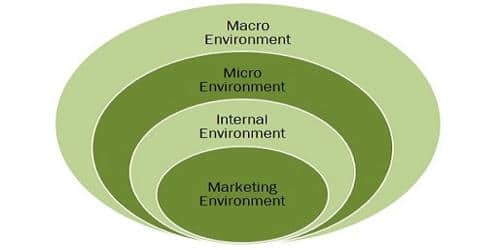Objectives
In this lesson, we will introduce you to the forces that define marketing’s external environment. After you work out this lesson, you should be able to:
· Identify, analyse and monitor external forces and assess their potential impacts on the firm’s goods and services
· Understand how marketers formulate their strategy within the frame of reference provided by the forces in the external environment
In this lesson, we will discuss the following:
· Competitive environment
· Political-legal environment
· Economic environment
· Technological environment
· Social-cultural environment
Introduction
Industry competition, legal constraints, the impact of technology on product design and social concerns are some of the many important conditions that shape the business environment. This lesson examines the forces that define marketing’s external environment. Every organization needs to think seriously about the environments in which it operates. All firms must identify, analyse and monitor external forces and assess their potential impacts on the firm’s goods and services. Although external forces frequently operate outside the marketing manager’s control, decision makers still must consider those ‘uncontrollable’ influences together with the variables of the marketing mix in developing the firm’s marketing plan and strategies.
Environmental Scanning and Environmental Management
Marketers must carefully and continually monitor crucial trends and developments in the business environment. Environmental scanning is the process of collecting information about the external marketing environment to identify and interpret potential trends. This activity then seeks to analyse the collected information and determine whether identified trends represent opportunities or threats to the company. This judgment, in turn, allows a firm to determine the best response to a particular environmental change.
Environmental scanning is a vital component of effective environmental management. Environmental management is the effort to attain organizational objectives by predicting and influencing the firm’s competitive, political-legal, economic, technological and social-cultural environments. The development of a global marketplace has complicated environmental scanning and environmental management. These processes may now need to track political developments, economic trends and cultural influences anywhere in the world.
While the marketing environment may exceed the confines of the firm and its marketing mix components, effective marketers continually seek to predict its impact on marketing decisions and to modify its conditions whenever possible.
The Competitive Environment
The interactive exchange in the marketplace as organizations vie with one another to satisfy customers creates the competitive environment. Marketing decisions by each individual firm influence consumer responses in the marketplace. They also affect the marketing strategies of competitors. As a consequence, decision makers must continually monitor competitors’ marketing activities – their products, channels, prices and promotions.
Few organizations enjoy monopoly positions in the marketplace. Utilities such as electricity, water and cooking gas accept considerable regulation from local authorities. Other firms, such as manufacturers of pharmaceutical products, sometimes achieve temporary monopolies as a result of patents. Marketers actually face three types of competition. Their most direct competition occurs among marketers of similar products, as when an insurance firm competes with other insurance firms. The second type of competition involves products that users can substitute for one another. In the transportation industry, the no-frills, low-cost airliners compete with train and luxury bus services. A change such as a price increase or an improvement in a product’s capabilities can directly affect demand for substitute products. The final type of competition occurs among all other organizations that compete for consumers’ purchases. Traditional economic analysis views competition as a battle among companies in a single industry or among firms that product substitute goods and services. Marketers must, however, accept the argument that all firms compete for a limited pool of discretionary buying power.
Because the competitive environment often determines the success or failure of a product, marketers must continually assess competitors’ marketing strategies. A firm must carefully monitor new product offerings with technological advances, price reductions, special promotions or other competitive variations, and the firm’s marketing mix may require adjustments to counter these changes.
The Political-Legal Environment
No one should start playing a new game without first understanding the rules, yet some businesses exhibit remarkably limited knowledge about marketing’s political-legal environment – the laws and their interpretations that require firms to operate under certain competitive conditions and to protect consumer rights. Ignorance of laws, ordinances and regulations or failure to comply with them can result in fines, embarrassing negative publicity and possibly expensive civil damage suits.
Businesses need considerable diligence to understand the legal framework for their marketing decisions. Numerous laws and regulations affect those decisions, many of them vaguely stated and inconsistently enforced by a multitude of different authorities. Regulations affect marketing practices, as do the actions of independent regulatory agencies. These requirement and prohibitions touch on all aspects of marketing decision making – designing, labelling, packaging, distributing, advertising and promoting goods and services. To cope with the vast, complex and changing political-legal environment, many large firms have in-house legal department; small firms often seek professional advice from legal experts. All marketers, however, should be aware of the major regulations that affect their activities.
Some of potential issues from the political-legal environment to affect businesses include:
· The national foreign policy can dominate the international business decisions of the local firms
· The political ideology of the Government can affect the international brands wanting to enter a market
· The competitors who work closely with the government can help erect trade barriers for a firm
· Global trade organizations can enforce trade barriers when their regulations and guidelines are not observed
· A host nation may levy anti-dumping duties on a foreign firm and such a decision may be dominated by the local businesses lobbying with the government
· Copyright infringements, trademark and intellectual property rights violations
· Direct comparative advertisements may not be allowed in few countries
· Use of children is advertising and advertising to children are banned in certain countries
· Price regulations pre-empt any pricing strategy of a firm
· A detailed displaying of the ingredients in product labels is mandatory in most countries
· The channel members are given the additional responsibility of verifying the eligibility of the prospective buyers for certain products
· Use of certain raw materials or methods of manufacturing are prohibited in certain countries
· Industry watch dogs and consumer groups are always on the prowl for any unethical trade practices.
Each one of the above issues has serious implications for the marketer in his marketing decision making. Ignorance of the law is no excuse and breaking of the law is an offence.
The Economic Environment
The overall health of the economy influences how much consumers spend and what they buy. This relationship also works the other way. Consumer buying plays an important role in the economy’s health. Indeed, consumer outlays perennially make up around two-thirds of overall economic activity. Since all marketing activity is directed toward satisfying consumer wants and needs, marketers must understand how economic conditions influence consumer buying decisions.
Marketing’s economic environment consists of forces that influence consumer buying power and marketing strategies. They include the stage of the business cycle, inflation, unemployment, resource availability and income.
Historically, a nation’s economy tends to follow a cyclical pattern consisting of four stages: prosperity, recession, depression and recovery. Consume buying differs in each stage of the business cycle and marketers must adjust their strategies accordingly. In times of prosperity, consumer spending maintains a brisk pace. Marketers respond by expanding product lines, increasing promotional efforts and expanding distribution in order to raise market share and raising prices to widen their profit margins. During recessions, consumers frequently shift their buying patterns to emphasize basic, functional products that carry low price tags. During such times, marketers should consider lowering prices, eliminating marginal products, improving customer service, and increasing promotional outlays to stimulate demand. Consumer spending sinks to its lowest during a depression. In the recovery stage of the business cycle, the economy emerges from recession and consumer purchasing power increases. While consumers’ ability to buy increases, caution often restrains their willingness to buy. They may prefer to save than to spend or buy on credit. Business cycles, like other aspects of the economy, are complex phenomena that seem to defy the control of marketers. Success depends on flexible plans that can be adjusted to satisfy consumer demands during the various business cycle stages.
Inflation devalues money by reducing the products it can buy through persistent price increases. It would restrict purchases less severely if income were to keep pace with rising prices, but often it does not. Inflation increases marketers’ costs such as expenditures for wages and raw materials and the resultant higher prices may therefore negatively affect sales. Inflation makes consumers conscious of prices, especially during periods of high inflation. This influence can lead to three possible outcomes, all of them are important to marketers. (1) consumers can elect to buy now, in the belief that prices will rise later, (2) they can decide to alter their purchasing patterns and (3) they can postpone certain purchases.
Unemployment is defined as the proportion of people in the economy who do not have jobs and are actively looking for work. It rises during recessions and declines in the recovery and prosperity stages of the business cycle. Like inflation, unemployment affects marketing by modifying consumer behaviour. Instead of buying, consumers may choose to build their savings.
Income is another important determinant of marketing’s economic environment, because it influences consumer buying power. By studying income statistics and trends, marketers can estimate market potential and develop plans for targeting specific market segments. For marketers, a rise in income represents a potential for increasing overall sales. But they are most interested in the disposable income, which is the amount of money that people have to spend after they have paid for necessities. Consumers’ disposable income varies greatly by demographic variables such as age group and educational levels.
Resources are not unlimited. Brisk demand may bring in orders that exceed manufacturing capacity or outpace the response time required to gear up a production line. A shortage may also reflect a lack of raw materials, component parts, energy or labour. Regardless of the cause, shortages require marketers to reorient their thinking. One reaction is demarketing, the process of reducing consumer demand for a product to a level that the firm can reasonably supply. A resource shortage presents marketers with a unique set of challenges. They may have to allocate limited supplies which is a sharply different activity from marketing’s traditional objective of expanding sales volume.
The Technological Environment
The technological environment represents the application to marketing of discoveries in science, inventions and innovations. New technology results in new goods and services for consumers; it also improves existing products, strengthens customer service and often reduces prices through new, cost-efficient production and distribution methods. Technology can quickly make products obsolete, but it can just as quickly open up new marketing opportunities. Technology is revolutionizing the marketing environment. Technological innovations not just create new products but also whole new industries. Recently, the Internet has been transforming the way companies collaborate with different stakeholders to create more value for the customers. Technology can sometimes address social and environmental concerns by offering a cheap, non-polluting, energy-conserving, safe product and also create parity among consumers by providing equal access and opportunity.
Marketers must closely monitor the technological environment for a number of reasons. Creative applications of new technologies give a firm a definite competitive advantage. Marketers who monitor new technology and successfully apply it may also enhance customer service.


